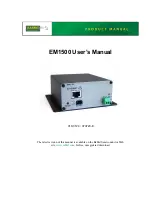
Types of Interrupts
10-10
Note:
Level-sensitive interrupts are not latched. If the interrupt is level-sensitive,
the condition must be present until the processor can respond to it. This is
most important if other interrupts are being used with a higher or equal prior-
ity. If the device is currently processing another interrupt of higher priority, the
condition must be present until the current interrupt is complete. This is be-
cause the level-sensitive interrupt is not sampled until the RETI instruction
is executed. Upon returning, if the level-triggered interrupting signal is not
there, it is as though the interrupt request was never issued.
The remaining four external interrupts are similar in nature, with one differ-
ence: INT2 and INT4 are positive edge detect only, while INT3 and INT5 are
negative edge detect only. These interrupts do not have level-detect modes.
All associated bits and flags operate the same and have the same polarity as
the first two interrupts. A logic 1 on an interrupt flag indicates the presence of
an interrupt condition, not the logic state of the input pin.
The flags that trigger external interrupts 2 through 5 are found in the EXIF (91
H
)
SFR, as shown in Table 10−7. When the appropriate condition (falling-edge
or rising-edge) is detected, the corresponding flag is set and the interrupt is
triggered, if enabled.
Note:
The bits in EXIF are set to 1 to indicate that the condition is true—the bits do
not represent the current level of the pin. That is, IE5 will be set to 1 when
a falling edge is detected on INT5, even though INT5 is at a logic 0 level at
that point.
Table 10−7.EXIF (91
H
) SFR
Bit
Name
Explanation of Function
7
IE5
External interrupt 5 flag – falling edge detected on INT5
6
IE4
External interrupt 4 flag – rising edge detected on INT4
5
IE3
External interrupt 3 flag – falling edge detected on INT3
4
IE2
External interrupt 2 flag – rising edge detected on INT2
3
−
Reserved (cleared to 1)
2
−
Undefined (cleared to 0)
1
−
Undefined (cleared to 0)
0
−
Undefined (cleared to 0)
There are three interrupts that can wake up the processor if it is in the
low-power IDLE mode: the external interrupts (INT0 and INT1), and the
Watchdog (when used as an interrupt). In order to be used to wake up the
processor, they must be enabled in the Wake Up Enable register, WUEN
(C6
H
).
Содержание MSC1210
Страница 1: ... December 2002 User s Guide SBAU077 ...
Страница 149: ...Digital Filter 12 13 Analog to Digital Converter Figure 12 5 Filter Frequency Responses ...
Страница 162: ...12 26 ...
Страница 234: ...Timers 17 6 Figure 17 4 Timer Counter 1 Mode 1 Figure 17 5 Interrupt System ...
Страница 273: ...Serial Port I O 17 45 Keil Simulator Figure 17 19 Clock Control Peripheral Figure 17 20 USART0 Preipheral ...
Страница 282: ...C 4 ...
















































